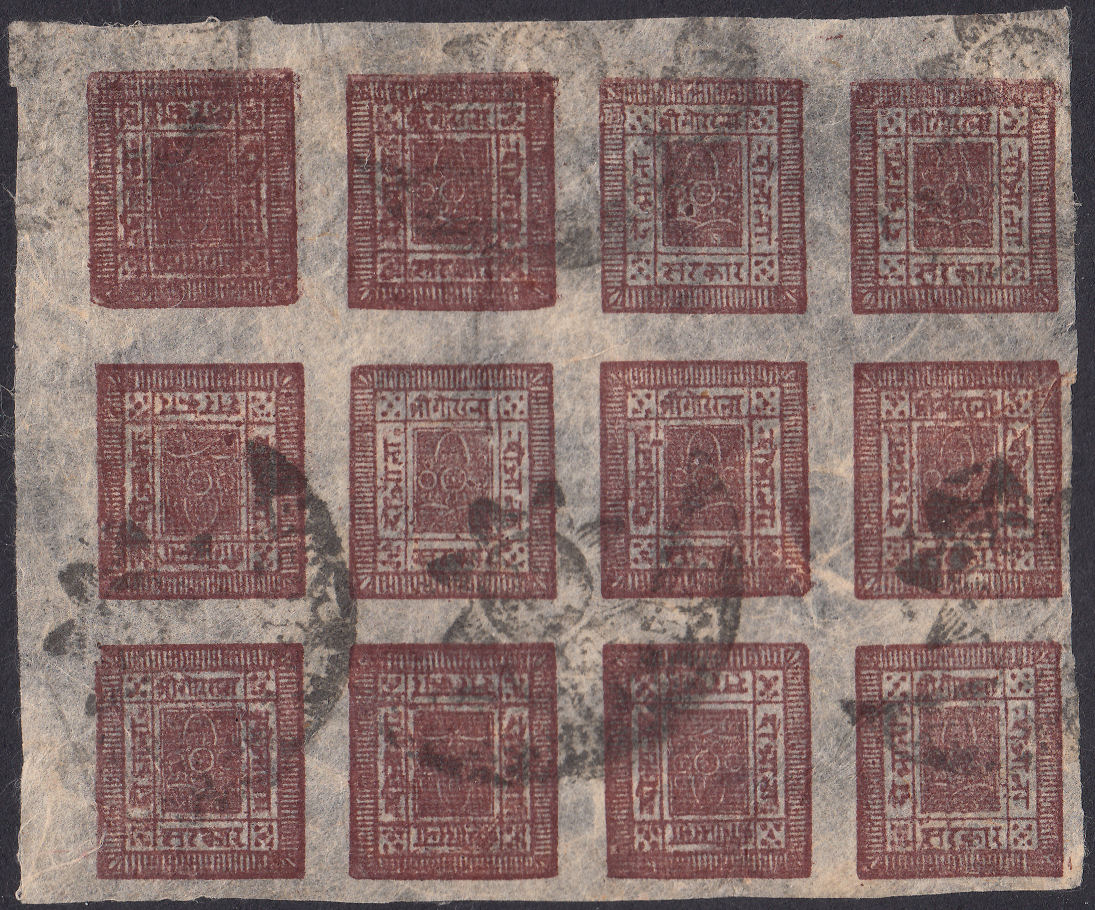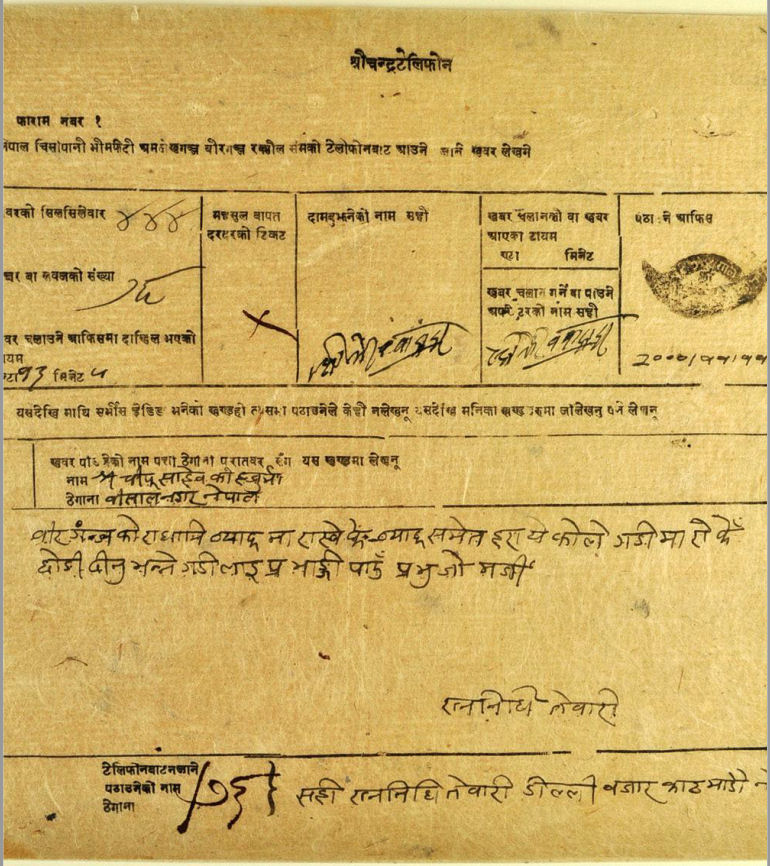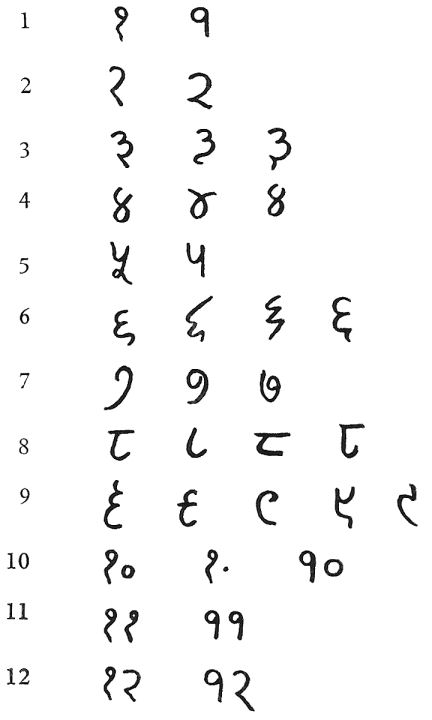| Up a level | |||||||||
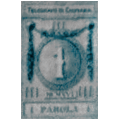 |
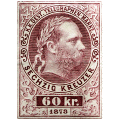 |
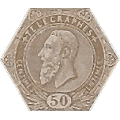 |
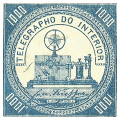 |
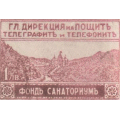 |
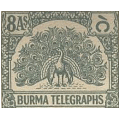 |
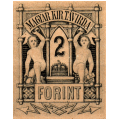 |
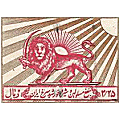 |
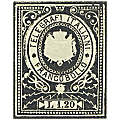 |
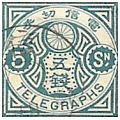 |
| Albania | Austria | Belgium | Brazil | Bulgaria | Burma | Hungary | Iran | Italy | Japan |
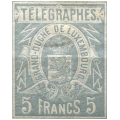 |
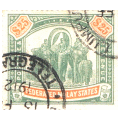 |
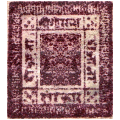 |
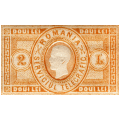 |
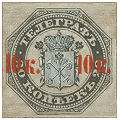 |
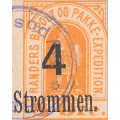 |
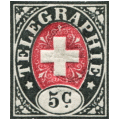 |
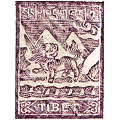 |
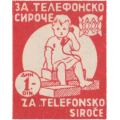 |
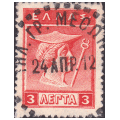 |
| Luxembourg | Malaya | Nepal | Rumania | Russia | Scandinavia | Switzerland | Tibet | Yugoslavia | Miscellaneous |
I have brought these prices up to date and added currency selection. I have also made some additions and used 'RH' numbers (Revised Hiscocks) for them. The original Hiscocks numbers are preserved. CheckList Setup |
NEPAL.
My notes:
1917 to 1930 Printed by Chapakhana Press, Kathmandu, in sheets, usually of rough native paper of variable thickness and hardness.
These were printed from the plates of old postage stamps (superseded in 1907) for telegraphic purposes, and the impressions are poor to very poor.
Initially the old stocks were used up, then new printings were made from the old plates.
Later the plates were 'recut' and later still the new 1 Anna die was produced.
These old plates were made with individual clichés for each stamp (originally 64 stamps).
These clichés could occasionally fall off, needing to be replaced. They were occasionally replaced upside-down leading to tête-bêche pairs.
In the case of H5, a 4 Anna cliché was replaced by a 1 Anna cliché (upside-down) at the top right corner of the sheet.
The new 1 Anna die did not have individual clichés and hence did not produce tête-bêche pairs
In use, messages were written on a form and the price calculated at 3/4 Annas per word. Stamps were glued to the back and cancelled.
The message was sent verbally by telephone and the receiving office transcribed them for delivery.
Hiscocks only priced the unused stamps in cases where they can be 'unambiguously distinguished' from the earlier postal use by shade or die.
I have added prices for the other mint stamps as well (marking them in red), but it is for the collector to decide what to collect.
Prices for used stamps, are for those with telegraph cancels. Be aware that some shades of these stamps were only used for the earlier postal purposes.
There are many forgeries about, particularly of H2, - I will try to get details of these.
According to nepalstamps.com, there are at most about 122 genuine mint copies of H2 and less than 400 used (H&V setting 6).
Nepalstamps.com have a specialised section of their website on the Nepalese telegraph stamps.
No watermark, no gum. Imperf.
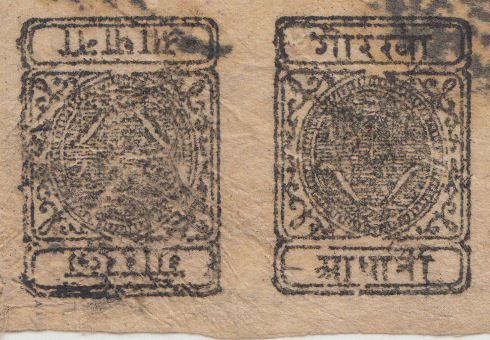 |
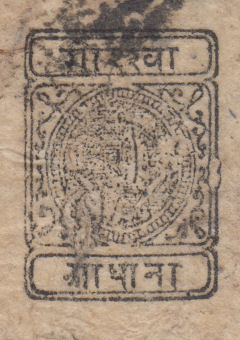 |
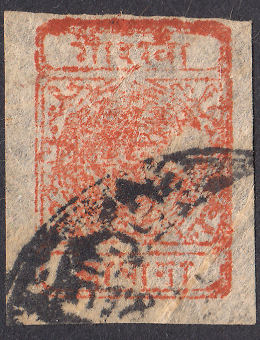 |
| ½ Anna, Hiscocks Type 1 (H1a) - Position 57/58 tête-bêche pair | ½ Anna, Hiscocks Type 1 (H1a) Position 42 'Double blister flaw'. |
½ Anna, Hiscocks Type 1 (H2) I'm told this is a forgery. |
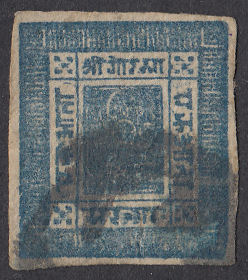 |
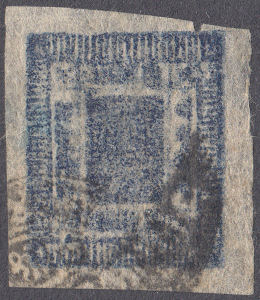 |
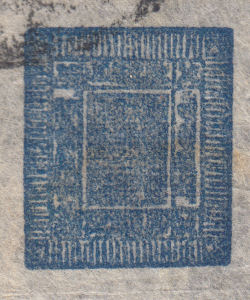 |
| 1 Anna, postally used | 1 Anna worn, Hiscocks Type 2 | 1 Anna recut, Hiscocks Type 2 - H3d |
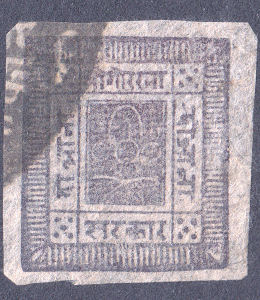 |
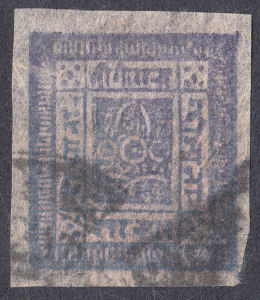 |
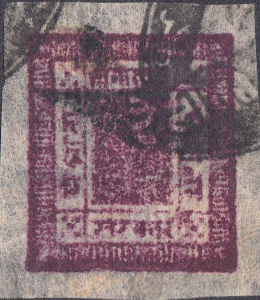 |
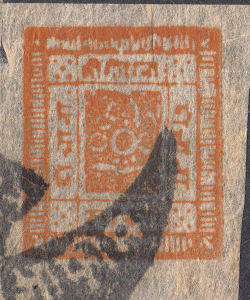 |
| 2 Anna shades, Hiscocks Type 3 | |||
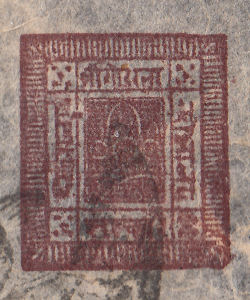 |
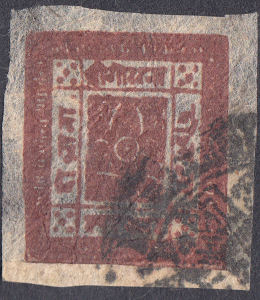 |
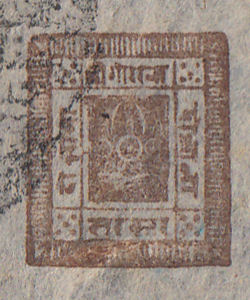 |
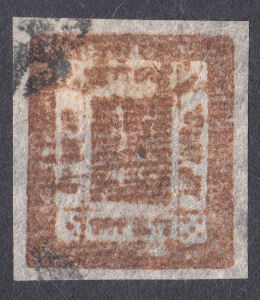 |
| 2 Anna shades, Hiscocks Type 3 | |||
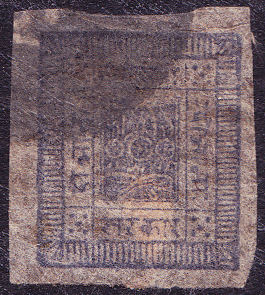
|
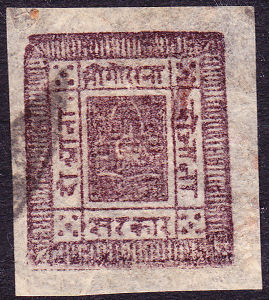
|
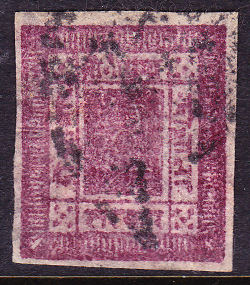
|
| Examples of 2 Anna shades - courtesy Max of Tilford stamps. | ||
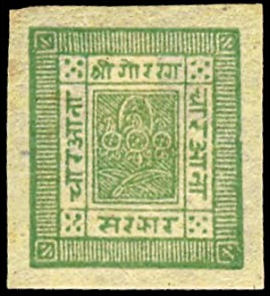 |
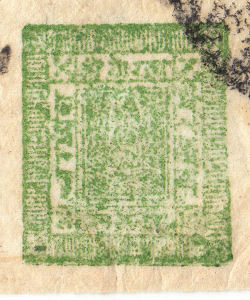 |
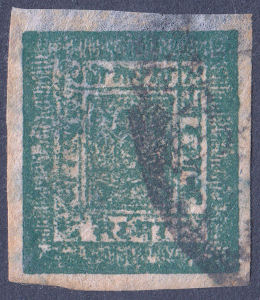 |
| 4 Anna shades, Hiscocks Type 4 | ||
| Early European paper, courtesy Raj Sukhani of Sukhanistamps. Postage only. |
A couple of mine on native paper, telegraphically used. | |
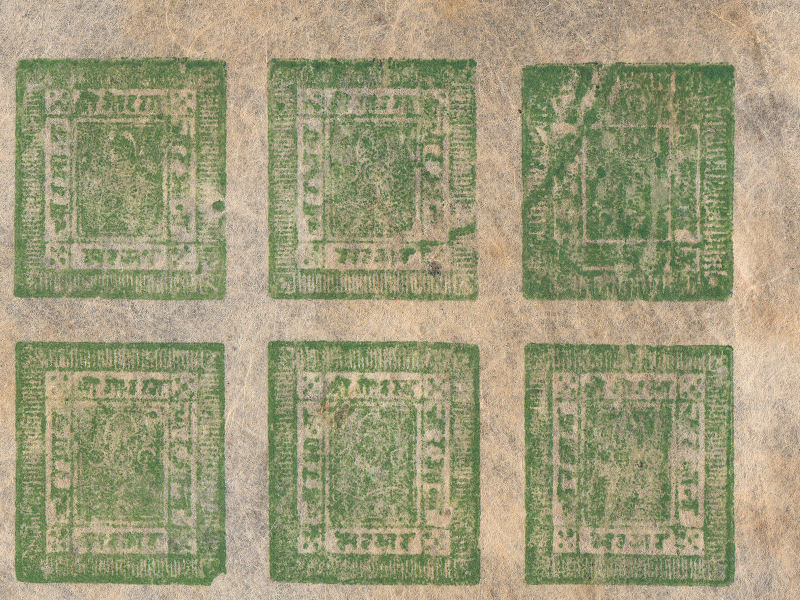
An example of the 1A green (H5/H5a) at the top right corner surrounded by 4A stamps (H11f).
The shades are very variable, particularly the 2As and not a good guide to the face value.
The value is at the top of the right-hand panel, and bottom of the left panel, though it is not always clear and is also a bit variable.
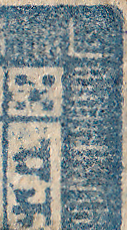 1 Anna (Type 2) |
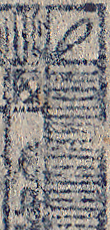 1 Anna (Type 5) |
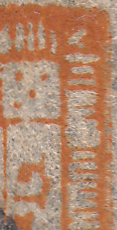 2 Annas |
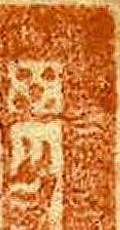 2 Annas |
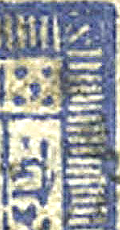 2 Annas |
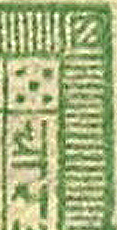 4 Annas |
| RH # | Hisc. | Type | Description | Mint | Used |
|---|---|---|---|---|---|
| RH1 | H1 | 1 | ½A black (1917-1928) | 20.00 | 1.00 |
| RH1a | H1a | tête-bêche (pair) | 70.00 | 4.00 | |
| RH1b | H1b | grey | 20.00 | 1.00 | |
| RH1c | H1c | grey tête-bêche (pair) | 70.00 | 5.00 | |
| RH1d | H1d | grey-black (1929-1930) | 7.00 | - | |
| RH1e | H1e | tête-bêche (pair) | 30.00 | - | |
| RH2 | H2 | 1 | ½A orange-vermilion (1917) | 1000.00 | 180.00 |
| RH2a | H2a | tête-bêche (pair) | - | 1000.00 | |
| RH3 | H3 | 2 | 1A blue (shades) | 12.00 | 2.00 |
| RH3a | H3a | tête-bêche (pair) | 50.00 | 8.00 | |
| RH3b | H3b | deep blue | 15.00 | 2.50 | |
| RH3c | H3c | deep blue tête-bêche (pair) | 60.00 | 10.00 | |
| *RH3d | - | deep blue re-cut | 12.00 | 2.00 | |
| *RH3e | - | re-cut tête-bêche (pair) | 50.00 | 8.00 | |
| RH4 | H4 | 2 | 1A pale emerald (error) (1917) | - | 100.00 |
| RH4a | H4a | tête-bêche (pair) | - | 400.00 | |
| RH4b | H4b | deep emerald | - | 150.00 | |
| RH4c | H4c | tête-bêche (pair) | - | 600.00 | |
| RH5 | H5 | 2 | 1A yellow green (shades) (error) (1930) | 300.00 | - |
| RH5a | H5a | se-tenant with No. 11f (pair) [see note] | 450.00 | - | |
| RH6 | H6 | 3 | 2A aniline carmine | 17.50 | 7.00 |
| RH6a | H6a | tête-bêche (pair) | 60.00 | 24.00 | |
| RH6b | H6b | brown-red (shades) | 15.00 | 6.00 | |
| RH6c | H6c | tête-bêche (pair) | 45.00 | 18.00 | |
| RH6d | H6d | venetian red | 17.50 | 7.00 | |
| RH6e | H6e | tête-bêche (pair) | 60.00 | 24.00 | |
| RH7 | H7 | 3 | 2A lavender | 15.00 | 6.00 |
| RH7a | H7a | tête-bêche (pair) | 45.00 | 18.00 | |
| RH7b | H7b | lilac (shades) | 15.00 | 6.00 | |
| RH7c | H7c | tête-bêche (pair) | 45.00 | 18.00 | |
| RH7d | ƒH7d | grey-blue (shades) | 38.00 | 15.00 | |
| RH7e | H7e | tête-bêche (pair) | 115.00 | 45.00 | |
| RH8 | H8 | 3 | 2A rose-mauve (shades) | 18.00 | 7.00 |
| RH8a | H8a | tête-bêche (pair) | 50.00 | 20.00 | |
| RH8b | H8b | red-purple (shades) | 18.00 | 7.00 | |
| RH8c | H8c | tête-bêche (pair) | 50.00 | 20.00 | |
| RH8d | H8d | claret | 15.00 | 6.00 | |
| RH8e | H8e | tête-bêche (pair) | 45.00 | 18.00 | |
| RH8f | H8f | magenta (shades) | 18.00 | 7.00 | |
| RH8g | H8g | tête-bêche (pair) | 50.00 | 20.00 | |
| RH9 | H9 | 3 | 2A maroon | 10.00 | 4.00 |
| RH9a | H9a | tête-bêche (pair) | 30.00 | 12.00 | |
| RH9b | H9b | brown-purple (shades) | 10.00 | 4.00 | |
| RH9c | H9c | tête-bêche (pair) | 30.00 | 12.00 | |
| RH9d | H9d | chocolate | 18.00 | 7.00 | |
| RH9e | H9e | tête-bêche (pair) | 54.00 | 30.00 | |
| RH9f | H9f | brown (shades) | 18.00 | 7.00 | |
| RH9g | H9g | tête-bêche (pair) | 54.00 | 30.00 | |
| RH10 | H10 | 3 | 2A sepia (1929-1930) | 12.00 | 4.00 |
| RH10a | H10a | tête-bêche (pair) | 45.00 | 15.00 | |
| RH10b | H10b | red-brown (shades) (1929-1930) | 9.00 | 3.00 | |
| RH10c | H10c | tête-bêche (pair) | 30.00 | 10.00 | |
| RH10d | H10d | chestnut (1929-1930) | 9.00 | 3.00 | |
| RH10e | H10e | tête-bêche (pair) | 27.00 | 10.00 | |
| RH10f | H10f | orange-brown (shades) (1929-1930) | 9.00 | 3.00 | |
| RH10g | H10g | tête-bêche (pair) | 27.00 | 10.00 | |
| RH11 | H11 | 4 | 4A green (shades) | 10.00 | 4.00 |
| RH11a | H11a | tête-bêche (pair) | 70.00 | 28.00 | |
| RH11b | H11b | blue-green (shades) | 15.00 | 6.00 | |
| RH11c | H11c | tête-bêche (pair) | 105.00 | 42.00 | |
| RH11d | H11d | bright emerald (shades) | 25.00 | 10.00 | |
| RH11e | H11e | tête-bêche (pair) | 175.00 | 70.00 | |
| RH11f | H11f | yellow-green (1929-1930) | 10.00 | 4.00 | |
| RH11g | H11g | tête-bêche (pair) | 70.00 | 28.00 | |
| RH11h | H11h | deep green (1929-1930) | 15.00 | 6.00 | |
| RH11i | H11i | tête-bêche (pair) | 105.00 | 42.00 |
My Notes: The Scott catalogue (2007) gives the same illustration (the 1 Anna) for the 1A, 2A and 4A leaving people to judge the value by the shade.
Given the range of shades, this has led to mistakes of identification being made, typically bluish 2A stamps described as 1A stamps.
*I have added H3d and H3e since, though Hiscocks mentions the re-cut 1A stamps, he did not list them as such. I thought them worth adding.
H4 is only known used and H5 (a 1A cliché in a 4A plate) is only known unused.
ƒH7d was originally 'grey-black (shades)' - I have never seen any, or any described as such. There are however grey-blue shades so I assumed it was a typo.
Steve Hiscocks only priced the unused stamps in cases where they can be 'unambiguously distinguished' from the earlier postal use by shade or die.
I have added prices for the other mint stamps as well (marking them in red), but it is for the collector to decide what to collect.
Hiscocks added the following 2 notes:
| Note 1. No. 2 is probably an error of colour, it is in fact in the colour which was used for the impressed post-card stamp. |
| Note 2. No. 5a occurs because a single 1A cliché was inserted in error into the 4A plate (position 8). It was inverted, so se-tenant pairs of the 1A & 4A are always tête-bêche. |
1928 to 1930 New die (type 5) with smaller lettering and larger centre (8 x 10½mm compared with 6¾ x 9mm).
The corners are very distinctive. Other details as before.
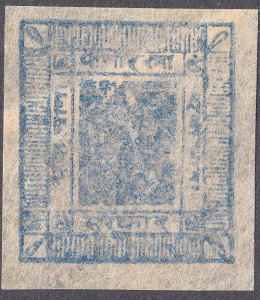 |
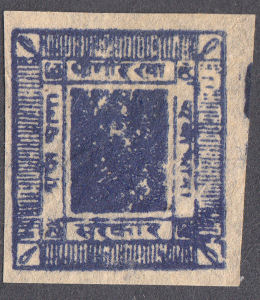 |
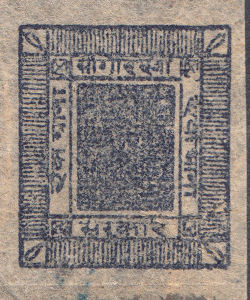 |
| 1 Anna, Hiscocks Type 5, H12 | 1 Anna, Hiscocks Type 5, H12a | 1 Anna, Hiscocks Type 5, H12b |
| RH # | Hisc. | Type | Description | Mint | Used |
|---|---|---|---|---|---|
| RH12 | H12 | 5 | 1A greyish blue (shades) | 10.00 | 2.50 |
| RH12a | H12a | deep blue (shades) | 10.00 | 2.50 | |
| RH12b | H12b | indigo | 12.00 | 3.00 | |
| RH12c | H12c | ultramarine (shades) | 15.00 | 5.00 |
The Scott catalogue illustrates this upside-down.
Hiscocks added the cancel illustrations below and the following 3 notes:
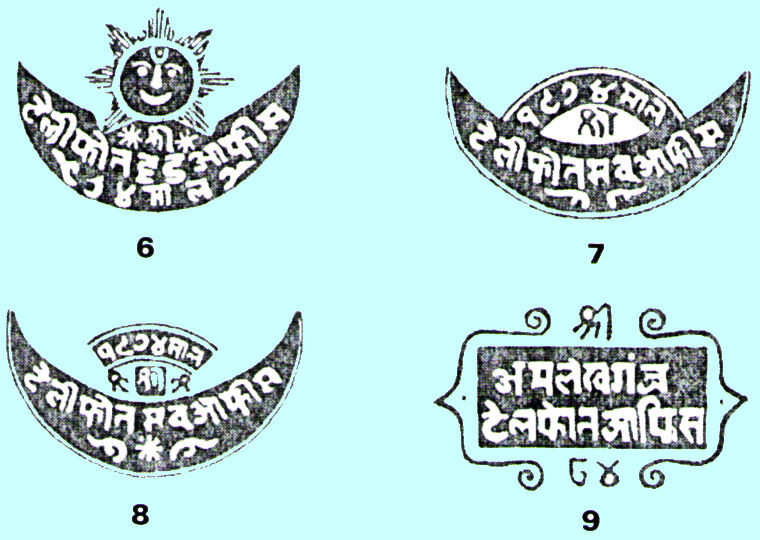
Further information can be found at nepalstamps.com.
| Note 1. All the above stamps were issued imperforate. Spurious 'pin-perforated' copies are occasionally found. |
| Note 2. The used prices above are for good copies cancelled with the telegraph/telephone cancellations illustrated (6,7,8,9). Of these: Type 6 was used at Kathmandu at the Head Office throughout the 1917 to 1930 period. Type 7 at the Chisapani Sub-Office and Type 8 and similar at the Birganj Sub-Office throughout the period. Type 9 was used at Amlekhganj from 1927 to 1930. A very few of these stamps were used postally. The postal cancellations are mostly circular and are very rare on telegraph stamps. |
| Note 3. Mint prices are only given when the mint stamp can be distinguished by colour or otherwise from the earlier postage stamps of the same type. |
My note: I read a reference to "trial pin-perforations mentioned by E.A.Smythies (Vignola collection)."
He was the person that found a number of sheets left over in the Kathmandu Treasury and first discovered H5.
The Scott catalogue lists them with a modest premium.
A premium of about 50% would seem reasonable, since they are fairly scarce but have uncertain status.
Where Hiscocks gives the use of these cancels up to 1930, they actually continued in use up to at least 1959 for telegraphic use of postage stamps.
See below for some examples.
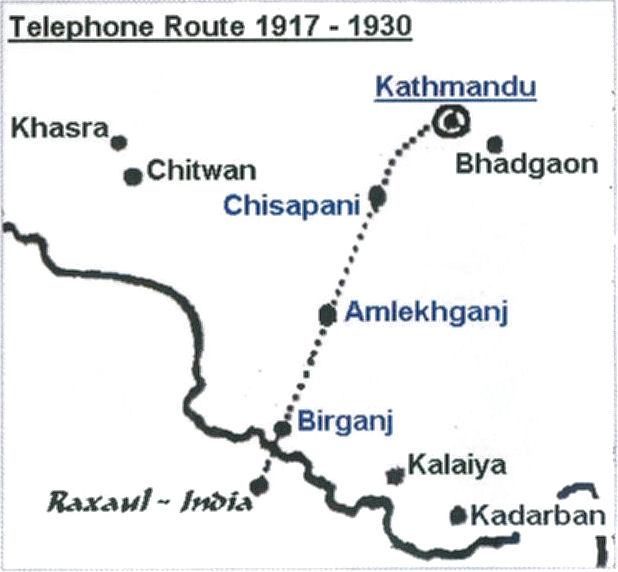
Map of the four offices courtesy of Edward Gosnell.
Examples.
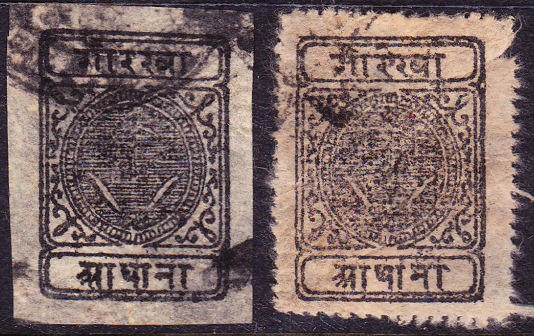 |
| Half Anna imperf. and pin-perf., courtesy Max of Tilford stamps |
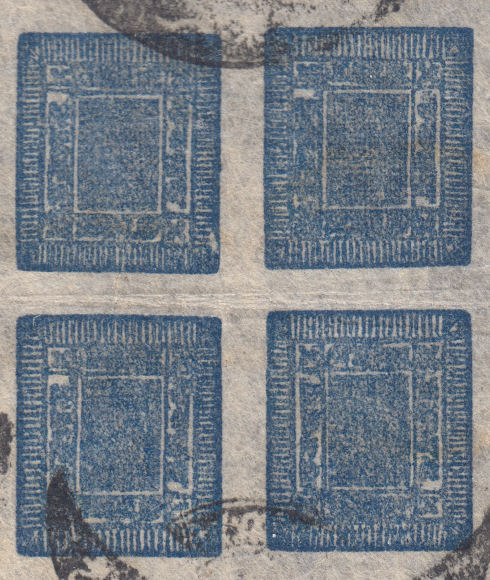 |
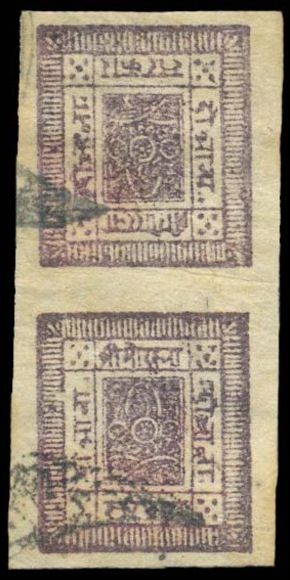 |
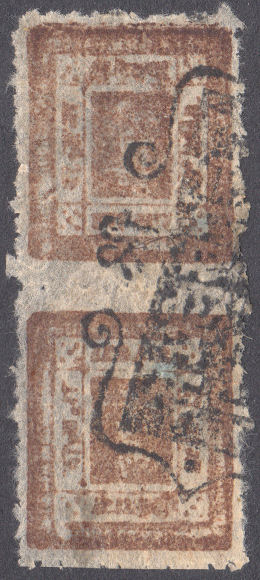 |
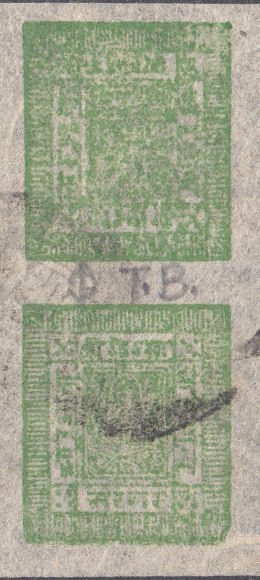 |
| 1 Anna re-cut, Hiscocks H3d/e | 2 Annas tête-bêche pair | 2 Annas tête-bêche pair - pin-perf. | 4 Annas tête-bêche pair (annotated!) |
| One of mine - spot the inverted cliché | Courtesy Raj Sukhani of Sukhanistamps | A couple of mine. | |
A note about the pin-perforations: The first postage stamps of 1881 were on gummed paper and perforated.
It is unlikely that any of these would have been in storage in 1917 when the telegraph line was established.
However from 1898 to 1901 pin-perforated stamps were available upon request. It is a matter of conjecture as to whether any would be in storage.
The stored stamps were used up very quickly and new stamps were printed. The Telegraph offices had no need for perforated stamps, and they were still valid for postage.
The 2 Anna pair shown above has a Amlekhganj cancel, that office did not open until 1927. It is likely that the perforations were added later.

This is a strip of 2 Anna stamps. Anyone using a Scott catalogue would probably call it 1 Anna because of the colour ! (courtesy Raj Sukhani of
Sukhanistamps)
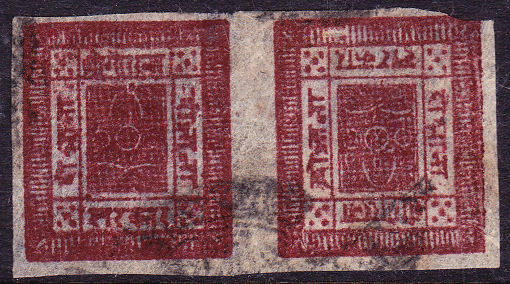
|
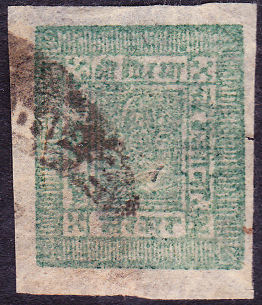
|
| A 2 Annas tête-bêche pair and a 4 Anna - courtesy Max of Tilford stamps. | |
As mentioned, the original plates were made up of individual clichés that occasionally became detached and had to be re-attached.
The fact that they were sometimes put back inverted, and the fact of occasional damage gave rise to
different settings of stamps and sometimes different states of the same 'H&V' setting.
Early work on this subject was produced (in Italian) by Wolfgang C. Hellrigl and Frank Vignola and
published by the 'Nepal and Tibet Philatelic Study Circle' (1 May 1984) as "The classic stamps of Nepal" (215 pages), ASIN: B0000ECG89
The sheets were originally of 64 stamps in 8 rows of 8.
For the purposes of identifying individual stamps, position 1 is at the top-left corner,
position 8 at the top-right and so on down the sheet to 64 at bottom-right.
Given the variability of shades in these, I am uncertain
how the black, grey and grey-black printings may be distinguished.
A single sheet appears to contain a range of shades.
Sometimes a single stamp will too.
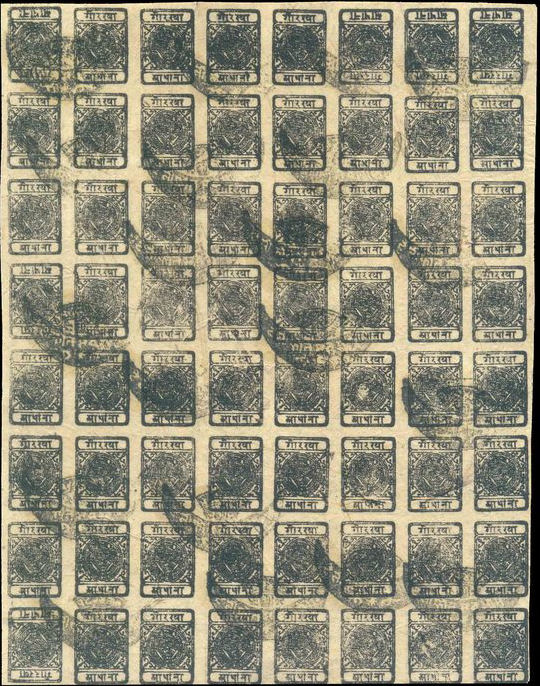
This sheet (courtesy Raj Sukhani of Sukhanistamps)
has inverted clichs at positions 1, 6, 7, 8, 25 and 57. This is [presumably] Setting 11.
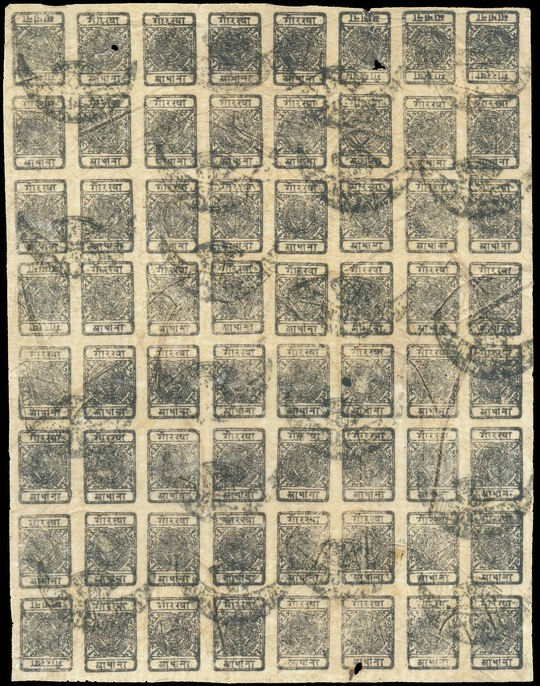
This sheet (courtesy Raj Sukhani of Sukhanistamps)
has inverted clichs at positions 1, 6, 7, 8, 25 and 57. This is [presumably] Setting 11.
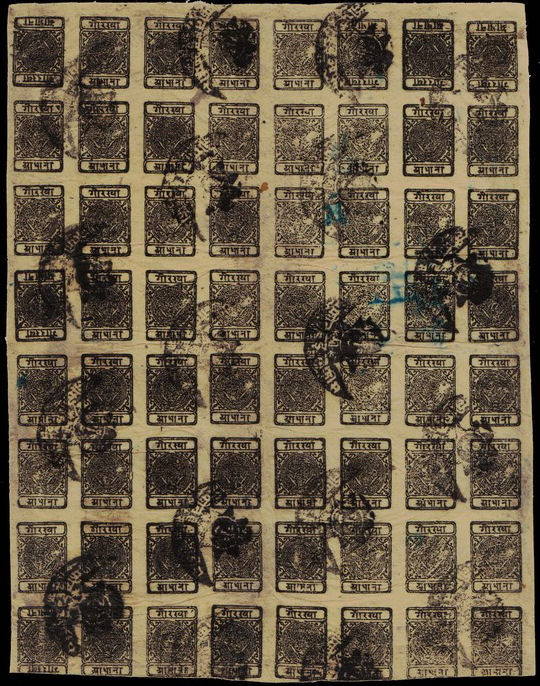
This sheet (courtesy Raj Sukhani of Sukhanistamps)
has inverted clichs at positions 1, 6, 7, 8, 25 and 57 and also has the 'double blister' flaw.
This is Setting 13.

A closeup of row 6 starting at H&V position 41 shows the 'double blister' flaw on 42 and associated flaws on 44 and 45.
Setting 13 and 14.
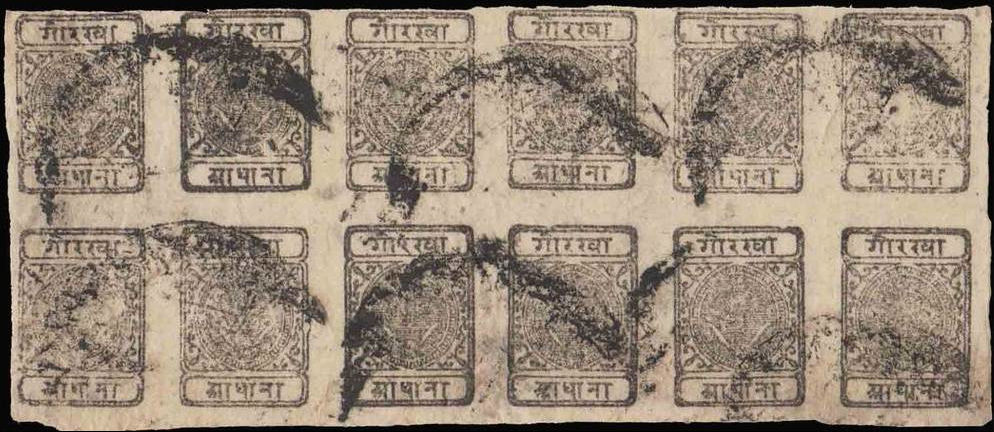
This block of 12 (courtesy Raj Sukhani of Sukhanistamps)
again shows the 'double blister' flaw on 42 and associated flaws on 44 and 45.
2A block of 12 from top-left corner, with 4 tête-bêche pairs. Kathmandu cancels.
(showing inverted clichs at positions 1, 8, 13 and 14)
2A setting 29, block of 52(nearly) from a sheet of 56 (half size), with 6 tête-bêche pairs. Birganj Sub-Office cancels.
(showing inverted clichs at positions 8, 14, 15, 18, 19 and 48, with 1 and 9 missing.)
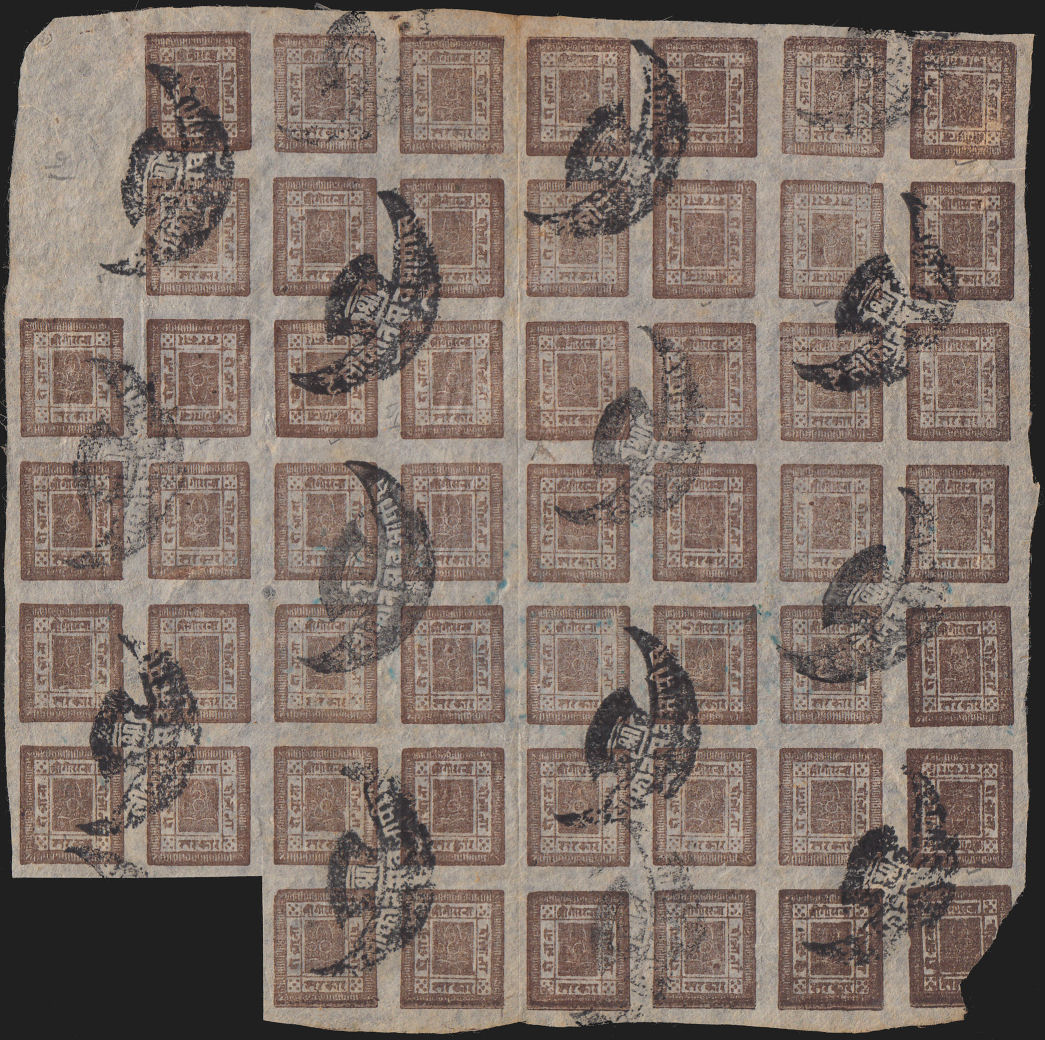
Here is a typical form of the period, half-size, courtesy of Richard Frajola :
See also Richards' Nepal Calling, 1917 to 1930 PDF document.
According to Hiscocks: "In 1930 the production of these 'special' stamps ceased and ordinary postage stamps came into use
although with the same or even more weird and wonderful cancellations."

This is a half-size block of 10, 4As stamps of the 1929 set courtesy of Rolf Lamprecht.
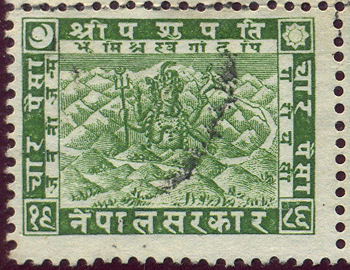
There was a set of four values (2p, 4p, 8p, 16p) in 1907 similar to this, but with only 5 characters in the bottom panel reading "Gurkha Sirkar" with a date of 1964 (local calendar) in the bottom corners.
This 1929 issue has 7 characters reading "Nepal Sirkar" and is dated 1986. This set has 6 values of this size with additions of 24p and 32p, together with larger 1R and 5R values.
There is a later 1935 issue (perf.14) with the date changed to 1992 and just the 6 low values. Then 1941-46 another series to 1R, redrawn and with perforations in the range 11 to 12.
An interesting note, the original Perkins, Bacon & Co (London) sheets were 10x10 sheets. During World War II supplies ran out in Nepal, and 4-wide sheets of 28, 36 or 40
were made by producing copper plates from photographs of original sheets. these were then line perforated. These were of very variable quality.
Here is a later form using Official stamps.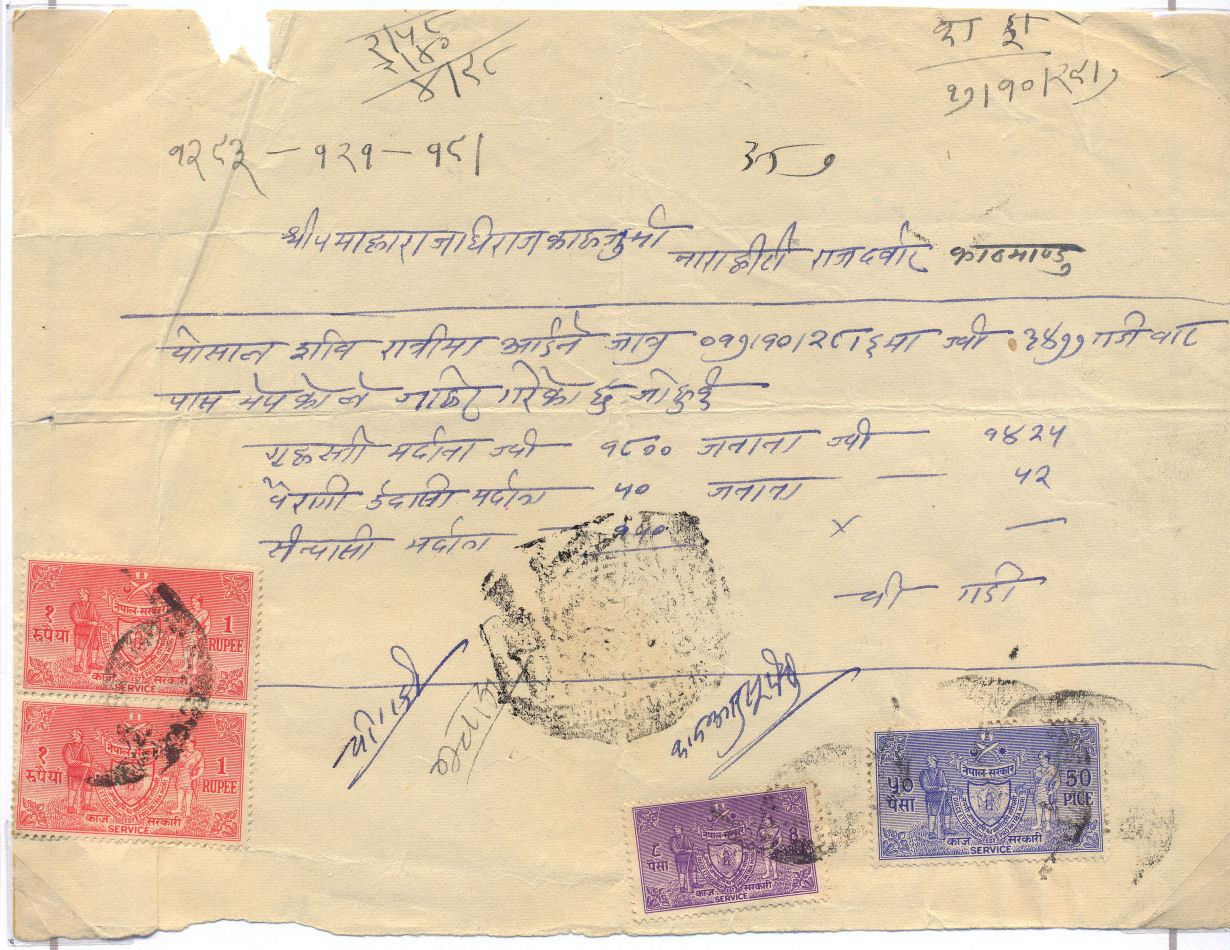
I'm not sure of the date of this, but it bears 2R58p in Official stamps of 1959. The set of these has small stamps of 2p, 4p, 6p, 8p and 12p, and large stamps of 16p, 24p, 32p, 50p, 1R and 2R.
This is also used in Chisapani. The stamps bear the Arms of Nepal and there is also a similar cachet. Image courtesy of Rolf Lamprecht.
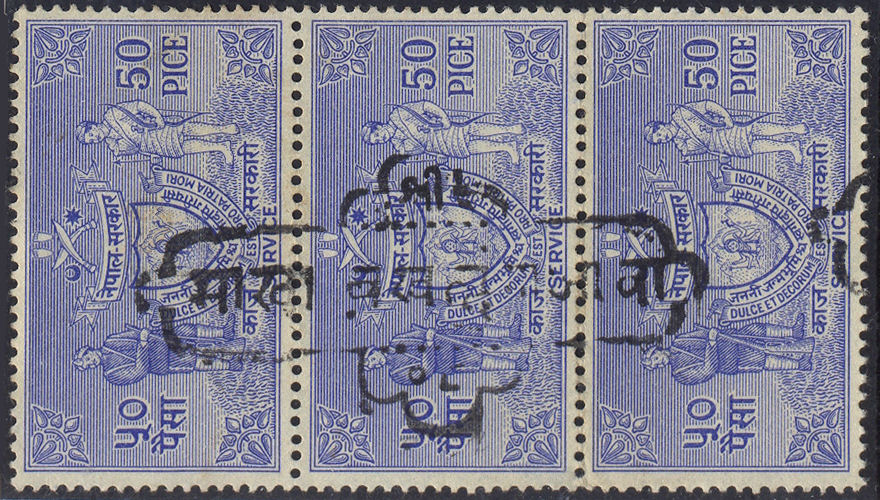
Another three of these stamps courtesy of Rolf Lamprecht. I was unsure of the cancel, but Richard Frajola did some investigating and told me it is described as :
"Drawing of previously unrecorded Okhaldunga tel/tel cancel" in 1988 Congress book article on Nepal Telephone / Telegraph stamps by Lester Michel. http://fuchs-online.com/ntpsc
If anyone can provide scans to help with this, I am happy to give appropriate credit.
Comments, criticisms, information or suggestions are always welcome.

Please include the word 'Telegraphs' in the subject.
Last updated 17th. June 2023
©Copyright Steve Panting 2012/13/14/15/16/17/18/19/20/21/22/23 except where stated.
Permission is hereby granted to copy material for which the copyright is owned by myself, on condition that any data is not altered and this website is given credit.
